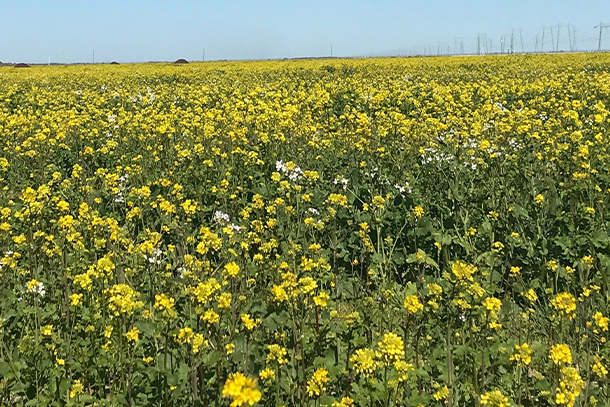The men and women at Hancock Farmland Services manage hundreds of acres of land up and down the Central Valley, including almond orchards. They are committed to sustainable farming practices and to being responsible stewards of the land. That includes doing all they can to support bees and pollinator health – a key component of a healthy almond industry.
In 2017, having heard about the Seeds for Bees program at the previous year’s Almond Conference, they decided to try for themselves. A modest investment that year on 16 acres outside an orchard in Chowchilla since has expanded to planting cover crops on more than 250 acres.
“As a grower, we are both in nature and a part of it,” said Samantha Lopes, operations support manager for Hancock. “We depend on it and it depends on us. Our goal is to improve long-term soil health and biodiversity. This practice allows us to obtain both.”
Seeds for Bees is organized by Project Apis m. (PAm.), one of the nation’s leading honey bee research organizations. The program encourages the planting of bee forage as part of riparian areas or cover crops in and around California farmlands to increase and provide variance in forage available to honey bees.
To participate in the Seeds for Bees program, growers can apply to receive seed mixes specifically designed to “bloom at critical times of the year when natural forage is scarce but managed and native bees are active,” according to Project Apis m. There are five different seeds mixes to choose from, each one best suited for specific soil types, climate and nearby crops.
In addition to providing food and habitat for bees, Almond Board-funded research shows cover crops could also provide other benefits to an orchard by:
- Adding organic matter to soil
- Increasing water infiltration and water-holding capacity
- Reducing pesticide runoff
- Providing a natural weed control
- Suppressing parasitic nematodes
- Driving carbon back into the soil
Planting additional forage is good for bees and good for pollination. Research funded by the Almond Board shows that supplementary forage does not compete with almond blossoms for pollination and improves bee health for robust hives.
Lopes said Hancock intentionally started small in 2017 to gauge the effectiveness of the program and to gain experience managing the cover crop.
“We planted around the perimeter of our recharge basin because the ground was already out of production,” she said. “This was a safe place to learn how to manage a cover crop with intensions to continually improve in the years to come. As our comfort level increased, in 2018, we branched out and planted another 35 acres of pollinator habitat on a property in Kern County.
“In 2019, we planted an additional 10 acres in Madera and Tehama County. By October of 2020, our managers planted just over 250 acres of pollinator habitat across the state. Our apiarist was very pleased and in years of plenty would bring bees out for longer periods of time to forage on the pollinator habitat.”
Last year, the company began planting inside the tree rows in some of its orchards – both to support bees as well as to improve the soil health in those areas.

“Our managers planted in every other row to allow for pruning to be chipped in the opposite row,” Lopes explained. “Going forward, each year we will alternate rows in hopes of creating a natural compost from the wood chippings and vegetation mulch. We believe this will boost microbial activity in the soil.”
She said the company’s farm managers are pleased with the results of the program.
“We have come a long way in building a diverse habitat,” Lopes said. “The more we learn, the more it pushes us to grow. We are by no means experts, but we are recognizing various benefits over time.”
She said Hancock’s spraying practices have not been impacted by the presence of cover crops.
“During bloom while the cover crop is growing, we conduct all of our sprays at night to protect our bees,” Lopes said. “The PCAs that our farm managers work with recommend bee-friendly materials, some of which come at a higher price. All mowing takes place during the early morning prior to bee activity. Lastly, we work with the beekeepers to provide clean, fresh water to keep the colonies healthy.”
What lessons has Hancock learned while implementing the Seeds for Bees program?
“Water is the key to everything, but it can also be scarce at times,” Lopes said. “Our field staff used water trucks immediately after planting to provide enough water on the ground until the first rainfall. Establishing germination is important for the longevity of a habitat, after planting.
“There are years of plenty and years of little. Our goal is to plant each year and allow Mother Nature to run its course. We’ve learned that the more consistently you plant, the more it comes back. ... Each year you plant, it comes in a little thicker.”
Lopes credited the Seeds for Bees program for underwriting the cost of the seeds for the first three years and always being available to answer questions or provide guidance. She offered this final bit of advice to other growers considering the program.
“Good stewardship is good business,” she said. “Protecting bee health doesn’t happen overnight, but we’d definitely endorse this program. It really can be a successful thing. … We’ve had a positive experience. Bee colonies need all the help they can get and it’s such a huge asset to growers in California, so why not try to help?”

